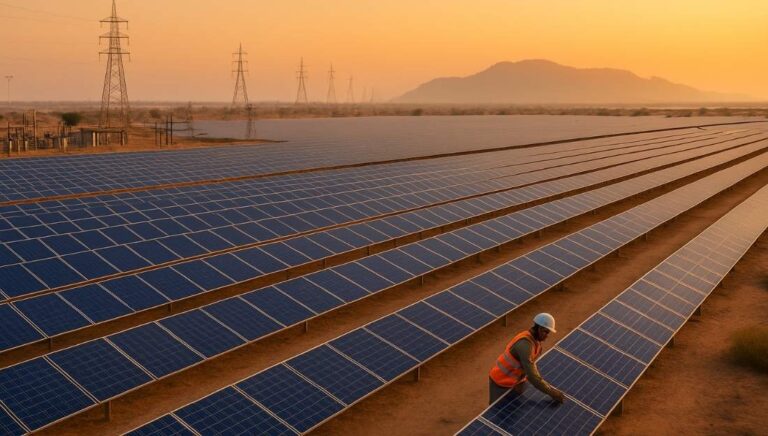India has emerged as the world’s third-largest producer of solar energy, surpassing Japan, and aims to become a global solar supplier, particularly to Africa, to sustain its growing domestic solar manufacturing industry.
Background
- India’s solar power industry has witnessed rapid expansion over the past decade, driven by policy support, technological innovation, and global climate commitments.
- The country’s shift toward renewable energy is central to meeting its Net Zero goals and reducing dependence on fossil fuels.

Rising Production and Capacity
- As per the International Renewable Energy Agency (IRENA), India generated 1,08,494 GWh of solar power in 2024–25, overtaking Japan.
- India now ranks third globally, behind China and the United States.
- Solar module manufacturing capacity surged from 2 GW in 2014 to about 100 GW in 2025, though the effective operational capacity is closer to 85 GW.
Domestic Installation
- India’s installed solar capacity reached 117 GW as of September 2025.
- Despite progress, the country still faces cost disadvantages compared to China, where modules are 1.5 to 2 times cheaper due to economies of scale and stronger supply chains.
Targets and Challenges
- 2030 Renewable Energy Goal: India aims to produce 50% of its electricity from non-fossil sources by 2030, totaling around 500 GW.
- Of this, 250–280 GW is expected from solar power, requiring an annual capacity addition of around 30 GW. However, the actual yearly addition remains at 17–23 GW, below the target.
- Export Challenges: India exported about 4 GW of solar modules to the U.S. in 2024, largely due to temporary American trade restrictions.
- In contrast, China exported over 236 GW, highlighting India’s limited global presence.
Way Forward: Becoming a Global Solar Supplier
- Serves as a critical habitat for endangered Himalayan species and promotes eco-tourism through sustainable activities like bird-watching and trekking.
- Helps protect high-altitude biodiversity and local ecosystems vital to the Western Himalayas.
Solar Park | Location | Capacity (MW) |
Bhadla Solar Park | Rajasthan | 2,245 |
Pavagada Solar Park | Karnataka | 2,050 |
Khavda Solar Park | Gujarat | 1,500+ (ongoing expansion) |
Ananthapuramu Ultra Solar Park | Andhra Pradesh | 1,500 |
Kurnool Ultra Mega Solar Park | Andhra Pradesh | 1,000 |
Rewa Ultra Mega Solar Park | Madhya Pradesh | 750 |
Charanka Solar Park | Gujarat | 690 |
Kamuthi Solar Plant | Tamil Nadu | 648 |
Radhnesada Solar Park | Gujarat | 280 |
Ananthapuramu – II Solar Park | Andhra Pradesh | 500 |
Conclusion
By building global partnerships, especially in Africa, and sustaining domestic demand, India can secure the long-term viability of its solar manufacturing industry and reinforce its role as a renewable energy powerhouse.
This topic is available in detail on our main website.





